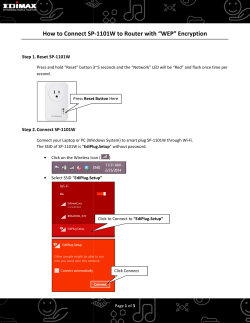
Do not brick your device Software Update on Embedded Systems
Software Update on
Embedded Systems
Do not brick your device
Stefano Babic
ELCE October 2014
Introduction
●
Me:
–
Software Engineer at DENX, Gmbh
–
U-Boot Custodian for Freescale's i.MX
–
Focus on Linux embedded with PowerPC and ARM
processors.
Agenda
●
Why upgrade ?
●
Why is it different with a Linux-PC ?
●
Upgrading strategies
●
Swupdate
Why do we need to update an
embedded system ?
●
It is not only hardware
●
Bug fixes
●
New features can be added
●
Security issues : heartbleed, bad implementation...
Why is ES different ?
●
Power failure
●
Bad firmware
●
●
Communication errors in
case of remote update
No access to target
Target must recover from errors !
Which elements must be
updated ?
●
Bootloader (dangerous !)
●
Kernel + DT
●
Root filesystem
●
Application data, other filesystems..
●
Customer data (migration )
●
Specific software (FPGA bitstream,...)
Where is a new SW installed ?
3 2 1 0 9 8
7 6 5 4 3 2 1 0
1 1 1 1
DIGITAL
TX
RX
AREF
GND
NOR
L
PWR
1
ADRUINO
USB
EXT
RESET
3V3
d0
47
25V
ICSP
d0
47
25V
PWR SEL
TX
RX
www.adruino.cc
POWER
5V Gnd Vin
ANALOG IN
0 1 2 3 4 5
NAND
FPGA
Which interface ?
●
●
Local:
–
Local storage (USB, SD,..)
–
Local peripheral (USB as device, UART,..)
Remote:
–
HTTP / web based
–
FTP
–
Proprietary protocol
–
Many more...
Who will update ?
X X
No expertise required
+
System upgrade solutions
●
Bootloader upgrade
●
Linux upgrade
–
Package Manager
–
Rescue image or specific application
–
From the running application
Bootloader
Limited access to peripherals (drivers, filesystems)
Implementation in bootloader not in sync with Linux
Limited network support (UDP, not TCP)
Limited UI with an operator
Update is simpler
Smaller footprint
Linux App
Footprint
Availability of all drivers used by the product
A lot of tools/libraries
package manager as distro ?
Upgrade is not atomic
Nightmare for test engineers/support
New firmware partially written
More places where things can go wrong
Small update image
Full update
Size, Time to transfer
Atomic: it works or not
Single image delivery
Double copy strategy
BOOT LOADER
Application Software
Running copy
Application Software
Standby copy
Databases, config, user data
BOOT LOADER
Application Software
Standby copy
Application Software
Running copy
Databases, config, user data
Single copy (rescue)
BOOT LOADER
SWUPDATE
Kernel + initrd
Application Software
Databases, config, user data
swupdate: FLOSS upgrade sw
●
Missing an open source upgrade software for ES
●
Take care of failure mechanism
●
Hardware / software compatibility
●
Proof correctness images to be installed (chksum,..)
●
Partitioning storage
●
Local or remote install
Swupdate-2
●
Scriptable (LUA), pre- and postinstall scripts
●
Single image for multiple devices
●
Easy for users to perform update
●
Missing : signed images !
Handling hardware differences
Brandon-Alvin
ViewerPane K600
Q UANTITY
OVERVIEW
MENU
ALARMS
HMI
Type A-1
Type A-2
Gateway
Type A-3
Type A-4
One release, multiple devices
Release XX.YY for device family
Software for A-1
Type A-1
Software for A-3
Brandon-Alvin
ViewerPane K600
QUA NTITY
OVERVIEW
MENU
Software for HMI
Type A-3
ALARMS
HMI
Single image structure
CPIO Header
sw-description
Image 1
Image 2
Image 3
Image i
Image n
Swupdate architecture
Notifier
Local Storage
Default
Parser
(libconfig)
INSTALLER
Custom
Parser
(LUA)
WebServer
API
Custom protocol
Handler manager
UBI
MTD
RAW
U-Boot
ENV
Custom
LUA
Handler
Handling HW differences
software =
{
version = "0.1.0";
target-1 = {
images: (
{
...
}
);
};
target-2 = {
images: (
{
...
}
);
};
}
sw-description
software =
{
version = "0.1.0";
myboard = {
hardware-compatibility: [ "1.2", "1.3", "18#010071"];
partitions: ( /* UBI Volumes */
{
name = "rootfs";
device = "mtd10";
size = 104896512; /* in bytes */
},
{
name = "kernel";
device = "mtd9";
size = 4194304; /* in bytes */
}
);
sw-description
images: (
{
filename = "core-image-base-myboard.ubifs";
volume = "rootfs";
},
{
filename = "uboot-env";
type = "uboot";
},
{
filename = "uImage";
volume = "kernel";
},
{
filename = "fpga.bin";
type = "fpga";
}
);
sw-description: scripts, u-boot
scripts: (
{
filename = "test.lua";
type = "lua";
},
{
filename = "sdcard.lua";
type = "lua";
},
{
filename = "test_shell.sh";
type = "shellscript";
}
);
uboot: (
{
name = "vram";
value = "4M";
}
Recovery from failures
U-Boot
Panic, watchdog,..
Reset
update flag
Kernel
boots
Update flag set ?
Bootcounter ?
Load
kernel
success
Swupdate
Set update
flag
run
fail
Application
Reset bootcounter
API for external client
swupdate
Client
REQ_INSTAL
L
ACK
DATA (IMAGE)
DATA (IMAGE)
DATA (IMAGE)
DATA (IMAGE)
DATA (IMAGE)
DATA (IMAGE)
DATA (IMAGE)
DATA (IMAGE)
GET STATUS
Status, Notification
GET STATUS
Status, Notification
Updating from browser
Using with Yocto
●
Meta-swupdate
●
It generates a ramdisk suitable for u-boot (.uboot.gz)
●
“dora” and “daisy” branches
●
Footprint RAMDISK (gzipped) : 2.6 – 7 MB
–
Typical: ~4MB
Handler in LUA
require ("swupdate")
fpga_handler = function(image)
print("Install FPGA Software ")
for k,l in pairs(image) do
print("image[" .. tostring(k) .. "] = " .. tostring(l) )
swupdate.notify(swupdate.RECOVERY_STATUS.RUN,0,
"image[" .. tostring(k) .. "] = " .. tostring(l))
end
return 0
end
swupdate.register_handler("fpga",fpga_handler)
swupdate todo list
●
Create a community around the project
●
Security: add support for signed images !
●
Low resources: support for full streamable image
●
New handlers
Links
●
Swupdate sources at
https://github.com/sbabic/swupdate
●
Documentation at http://sbabic.github.io/swupdate
●
Mailing list: swupdate@googlegroups.com
●
http://www.denx.de/
Questions ...
●
It's your turn now...
© Copyright 2025





















